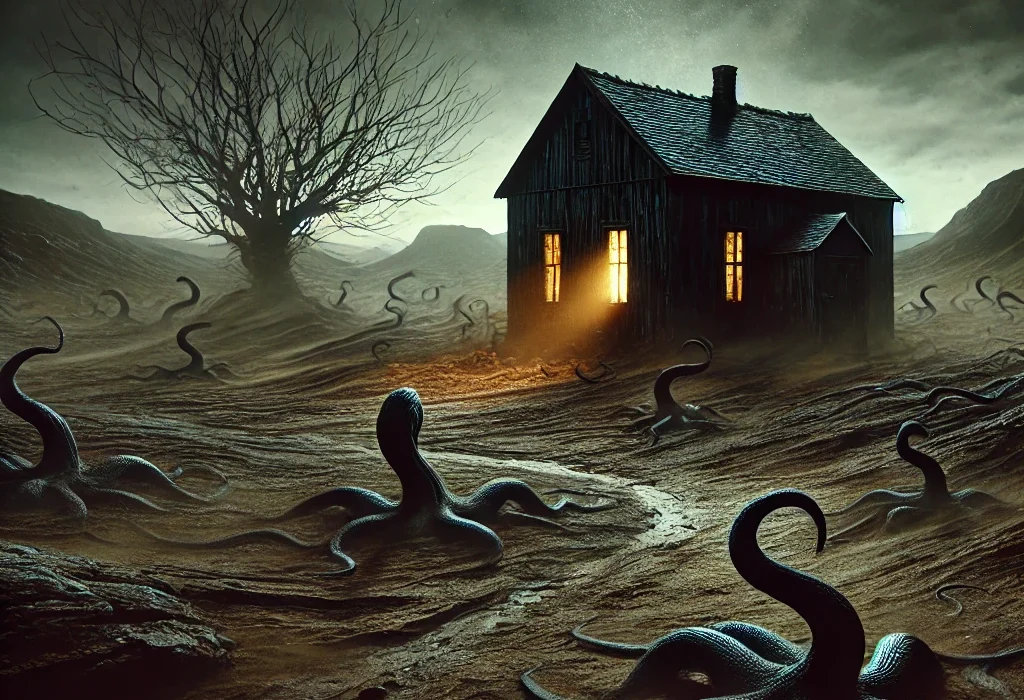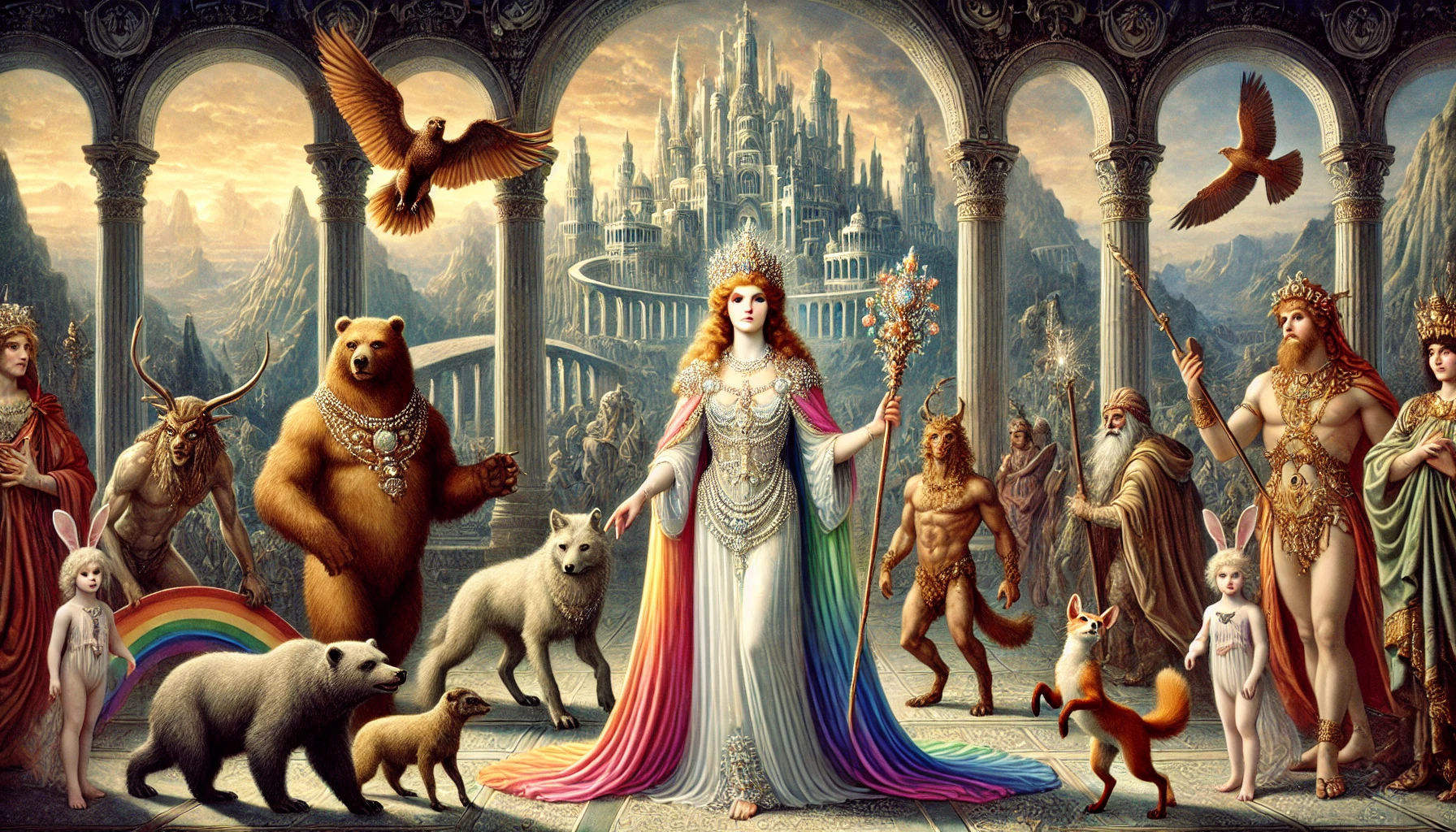“The Curse of Yig” by H.P. Lovecraft, published in 1929, delves into the realm of cosmic horror, a signature element of Lovecraft’s storytelling. Set against the eerie backdrop of the Oklahoma plains, this tale intertwines Native American folklore and the terrors of the unseen, focusing on the ancient serpent god Yig. Lovecraft crafts a narrative that blurs the line between myth and reality, exploring how deeply embedded cultural legends can shape—and ultimately unravel—the minds of those who encounter them. As with many of Lovecraft’s stories, the theme of mankind’s insignificance in the face of ancient, unknowable forces looms large, inviting readers into a world where fear is both a psychological and a supernatural entity.
Plot Summary
In 1925, a researcher specializing in Native American cultures ventures deep into the heart of Oklahoma, seeking out ancient snake lore. Driven by a professional curiosity about serpent worship among indigenous tribes, he encounters an unexpected and unsettling terror that instills in him a lifelong fear of snakes. The locals, both the old pioneers and the Native Americans, are tight-lipped about the subject, offering him little more than whispers and vague hints. They direct him to an asylum in Guthrie, where they claim a relic from this dark mythology is kept—a living testament to the curse of Yig.
At the asylum, the researcher meets Dr. McNeill, an elderly but scholarly figure, who reluctantly agrees to show him the terrible creature. He leads the researcher down into the bowels of the building, where they stand before a door with a small observation panel. Dr. McNeill warns him that what he is about to see is not a supernatural being but a tragic product of dark beliefs. Peering through the panel, the researcher is overwhelmed by a nauseating stench and the sight of a writhing figure, something neither fully human nor fully snake, sprawled on the floor of the dimly lit cell. The creature’s form and movements are too grotesque for the mind to fully comprehend, causing the researcher to reel back in horror.
Back in the doctor’s office, the researcher learns the horrifying backstory of this creature. The tale begins with Walker Davis and his wife, Audrey, who journeyed from Arkansas to the newly opened lands of Oklahoma in the spring of 1889. Like many pioneers, they hoped for a fresh start on the frontier. Yet, Walker carried with him an almost pathological fear of snakes, a fear that had been with him since childhood, when an old Indian squaw had prophesied a dreadful serpentine end for him. This fear would only grow stronger as he learned of the local legends surrounding the snake-god, Yig.
Yig, the serpent deity worshiped by the indigenous tribes of the plains, was said to be a capricious and vengeful god. While he could be benign, he was fiercely protective of his children, the snakes, and those who harmed them would face his wrath. The tales described how, in autumn, Yig would exact revenge on those who had killed his progeny, turning them into spotted serpents. Walker was fascinated and terrified by these stories, becoming increasingly paranoid about encountering snakes on their journey.
The Davises eventually settled on a piece of land in the Wichita country, surrounded by a landscape that promised fertility but was steeped in an eerie stillness. Walker, consumed by his fear, began to see potential snake dens in every shadow and stony crevice. Despite his precautions and the charms he obtained from the Native Americans to ward off Yig’s wrath, his anxiety only grew. Audrey, initially more pragmatic, began to absorb some of Walker’s terror as the months passed.
One day, Audrey stumbled upon a nest of baby rattlesnakes near their camp. Knowing Walker’s fragile state of mind, she decided to kill them herself, hoping to spare him the horror of their presence. Taking up a stick, she beat the nest until every last serpent was dead. When Walker found out, he was horrified and convinced that this act had sealed their fate. He believed Audrey had drawn the curse of Yig upon them, and his obsession deepened into a kind of madness.
As autumn approached, the atmosphere around them grew increasingly tense. The Native American tribes began their annual rites to drive away Yig and protect their lands from his wrath. The rhythmic pounding of tom-toms echoed across the plains, creating a dissonant symphony with the howling wind. To Walker, the sound was a source of reassurance, a barrier against the lurking evil. To Audrey, it was an unending reminder of the doom that hung over them.
Halloween came, bringing with it a rare moment of levity. The Davises hosted a gathering at their cabin, inviting neighbors for a night of dancing and celebration. For a brief time, the fears that had haunted them seemed to dissipate in the warmth of human company. But as the last guests left and the cabin grew quiet, the terror returned. Walker and Audrey went to bed, the rhythmic drumming of the distant tom-toms still beating in the background.
In the dead of night, Audrey awoke from a nightmare to find Walker already sitting up, listening to a strange rustling sound. A low, insidious hiss filled the room. Walker, lantern in hand, moved to investigate, but before they could comprehend what was happening, the room was plunged into darkness. In the brief flash of light, Audrey saw it—the floor of the cabin was alive with writhing snakes of every size and variety, their scales glistening in the lantern’s glow. Walker collapsed to the ground, and the lantern went out, plunging them into total darkness.
Audrey lay frozen in terror, her mind swirling with images of Yig and his vengeance. In the darkness, she heard a dreadful, wet popping sound, as if something had burst. The smell of decay and poison filled her nostrils. Her husband had fallen silent, and in her madness, she imagined that the snakes had begun to transform him into one of their own. When she heard movement again, something fumbling toward her in the dark, she was convinced it was Yig himself.
Seizing the axe that hung by the bed, Audrey lashed out wildly, hacking at the shadowy figure. Only when it was over did the pale light of dawn reveal the truth. Walker lay at her feet, his body mutilated not by snakes, but by her own hand. The lantern had shattered in his grasp, and he had died not from snakebite, but from Audrey’s frenzied attack.
By the time the neighbors arrived the next morning, Audrey had descended into complete madness. They found her cradling the remains of her husband, surrounded by the corpses of the snakes that had somehow invaded their home. Her mind shattered by fear and grief, she could do nothing but hiss, an eerie mimicry of the creatures that had haunted her dreams.
In the months that followed, Audrey was committed to the asylum. Despite periods of lucidity, her transformation continued. Her hair turned white and fell out, her skin grew blotchy, and eventually, she gave birth to a monstrous, reptilian child—a living symbol of Yig’s curse, or perhaps merely the tragic result of a mind twisted by terror.
The researcher listens to Dr. McNeill’s story in stunned silence. What he has seen in the cell below is the product of this dark history—a being born of fear, madness, and ancient, incomprehensible powers. As he leaves the asylum, the echo of those distant tom-toms seems to follow him, a haunting reminder of the ancient curses that lie sleeping in the depths of the world, waiting to awaken.
Main Characters
- Walker Davis: A pioneer with a paralyzing fear of snakes, which is exacerbated by the local legends of Yig. His terror leads to his ultimate demise.
- Audrey Davis: Walker’s wife, who tries to protect her husband from his fears but ends up succumbing to the same dread, ultimately losing her sanity.
- Dr. McNeill: The head of the asylum who tells the researcher the story and shows him the horrific creature that is the product of Yig’s curse.
- Yig: The serpent god, an ominous presence throughout the story, representing ancient, primeval terror.
Theme
- Fear and Paranoia: The story explores how fear, particularly irrational fear, can dominate and ruin lives. Walker’s terror of snakes becomes a self-fulfilling prophecy.
- Cultural Beliefs and Superstition: The power of Native American folklore and legends, particularly those surrounding Yig, showcases how deeply cultural beliefs can influence individuals, even to the point of madness.
- Transformation and Punishment: Yig’s curse symbolizes a transformation as a form of punishment, turning those who offend him into a reflection of their own fear.
Writing Style and Tone
H.P. Lovecraft’s writing in “The Curse of Yig” is characteristic of his style, with a focus on cosmic horror and the insignificance of humanity. His narrative is rich in atmosphere, building a sense of creeping dread through detailed descriptions and a slow, inexorable progression toward terror. Lovecraft employs an archaic and dense prose style, lending an air of antiquity and formality to the story. The tone is ominous and foreboding, enhancing the feeling of helplessness in the face of ancient, unknowable forces.
The narrative technique of using a framing device—a researcher recounting a tale told to him—creates a layer of distance, making the horror more abstract and thus more unsettling. Lovecraft’s use of indirect description and suggestion allows readers’ imaginations to fill in the gaps, often leading to a more personal and terrifying experience.
We hope this summary has sparked your interest and would appreciate you following Celsius 233 on social media:
There’s a treasure trove of other fascinating book summaries waiting for you. Check out our collection of stories that inspire, thrill, and provoke thought, just like this one by checking out the Book Shelf or the Library
Remember, while our summaries capture the essence, they can never replace the full experience of reading the book. If this summary intrigued you, consider diving into the complete story – buy the book and immerse yourself in the author’s original work.
If you want to request a book summary, click here.
When Saurabh is not working/watching football/reading books/traveling, you can reach him via Twitter/X, LinkedIn, or Threads
Restart reading!








